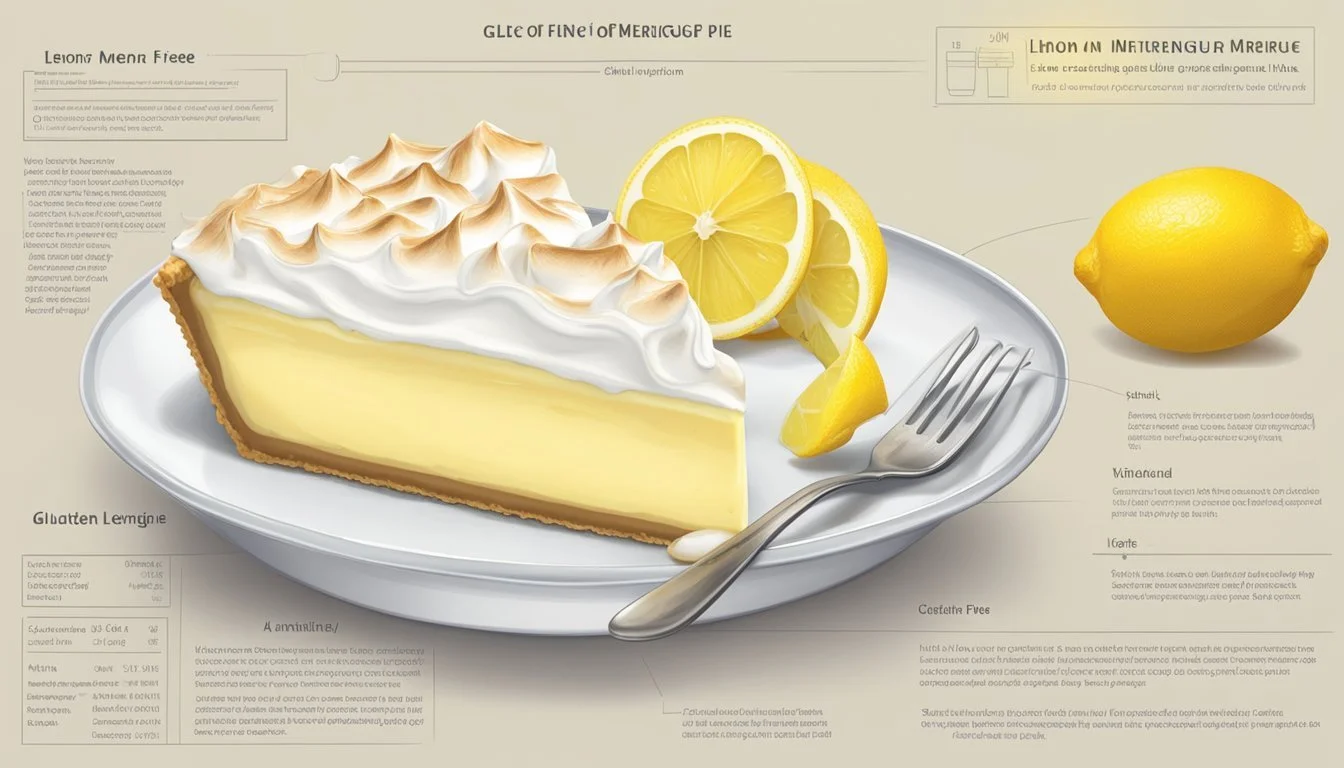Is Lemon Meringue Pie Gluten-Free?
Unveiling the Facts about This Classic Dessert
Lemon meringue pie is a classic dessert featuring a flaky crust, tart lemon filling, and a fluffy, toasted meringue topping. Traditionally, this pie is not gluten-free due to the flour used in the crust. However, with the increasing awareness and need for gluten-free options, adaptations of this beloved dessert are now commonly available to accommodate those with gluten intolerance or celiac disease.
To make a gluten-free lemon meringue pie, it is essential to use gluten-free alternatives for the crust such as blends of rice, almond, or coconut flours. The lemon filling and meringue topping are naturally gluten-free, focusing concern primarily on the pie crust. Care must also be taken to ensure that all ingredients, such as cornstarch or baking powder, are certified gluten-free to prevent cross-contamination.
For individuals following a gluten-free diet, the availability of gluten-free lemon meringue pie means they can enjoy the same delicious dessert without compromising their health or taste preferences. Specialty bakeries often cater to gluten-free needs, and a myriad of recipes are available for those who wish to bake the pie at home, ensuring that the dessert remains a treat everyone can savor.
The Basics of Lemon Meringue Pie
Lemon meringue pie is a classic dessert that balances tart lemon filling with sweet, fluffy meringue atop a crisp crust. Understanding its components and the presence of gluten is vital for those with dietary restrictions.
What Is Lemon Meringue Pie?
Lemon meringue pie consists of three main components:
Crust: Typically made from flour, the crust serves as the base of the pie, providing texture and structure.
Lemon Filling: A mixture of lemon juice, water, sugar, and a thickening agent (often cornstarch) creates a tangy and smooth lemon curd.
Meringue: Egg whites and sugar are beaten to form soft peaks, providing a light and airy topping that is then browned in the oven.
Identifying Gluten in Pies
Gluten is a group of proteins found in certain grains, with the primary sources being wheat, barley, and rye. In pies, gluten is usually found in:
Pie Crust: Traditionally, pie crust is made from wheat flour, which contains gluten.
Thickening Agents: Certain thickening agents for fillings may include gluten.
For a pie to be gluten-free, both the crust and filling must contain alternative ingredients that do not contain gluten, such as:
Gluten-Free Flour: Suitable for the crust, it can be made from rice, almond, or coconut flour, among others.
Cornstarch: Often used in the lemon filling, it is a naturally gluten-free thickening agent.
When crafting a gluten-free lemon meringue pie, one must scrutinize each ingredient to ensure compliance with a gluten-free diet, paying special attention to the flour used in the crust and confirming that all components are certified gluten-free if necessary.
Crust Considerations for Gluten-Free Options
When crafting a gluten-free lemon meringue pie, the crust is of paramount importance. It requires specific gluten-free ingredients and techniques to produce a pie crust that rivals its gluten-containing counterpart in both taste and texture.
Gluten-Free Pie Crust Basics
The foundation of any gluten-free pie, including lemon meringue, begins with selecting the right mix of gluten-free flours. A combination of tapioca starch, cornstarch, and a primary gluten-free flour like rice flour ensures the crust maintains a desirable texture. Xanthan gum is often added as a substitute for gluten, providing the elasticity and stickiness needed to hold the crust together.
Substituting Flours
Gluten-free baking is not a one-size-fits-all scenario; flours must be chosen wisely. For instance, tapioca starch contributes to a crispy texture, while cornstarch aids in binding the ingredients. One can typically substitute gluten-containing flours with a gluten-free flour mix in a 1:1 ratio, or blend their own mix using ingredients such as rice flour, tapioca starch, potato starch, and xanthan gum for structure.
Preparation Techniques
When preparing a gluten-free pie crust, techniques slightly differ from traditional crusts. After mixing the dough, it's essential to chill it, which makes it easier to handle. Use parchment paper to roll out the dough to prevent sticking. Blind baking — partially baking the crust with pie weights or dried beans before filling — is crucial to prevent a soggy bottom. Par-bake the crust just until it's set to ensure a crisp base that holds up well under the lemon filling and meringue.
Lemon Filling: Achieving the Perfect Tartness
The success of a lemon meringue pie's filling lies in its ability to balance a tart, citrusy bite with just the right thickness and consistency. Mastering the optimal tartness and creating a gluten-free lemon filling requires particular attention to ingredients and technique.
The Role of Lemon
Lemons, the star of the lemon filling, impart the necessary tartness. Lemon juice and lemon zest are the two components extracted from lemons to infuse the filling with a bright, citrusy flavor. The zest, rich in oils, enhances the lemon's aroma, while the juice provides the unmistakable tangy kick. The quantity and balance of lemon juice and zest directly affect the tartness of the filling, requiring careful measurement to achieve the desired intensity.
Creating a Gluten-Free Filling
Gluten-free lemon filling eliminates the use of traditional flours, utilizing alternatives like cornstarch to achieve the right thickness. Cornstarch is a key gluten-free ingredient that acts as a thickener without introducing gluten, making it suitable for those with gluten sensitivities or celiac disease. When selecting ingredients, one must ensure that all components, including cornstarch and any additional thickeners, are certified gluten-free to avoid cross-contamination.
Consistency and Cooking Techniques
The consistency of the lemon curd is critical—it must be thick enough to support the meringue yet sufficiently silky to contrast with the crust. This is where eggs play a pivotal role. Egg yolks contribute to the richness of the lemon curd, while stiff peaks formed from egg whites are reserved for the meringue topping. The mixture should be brought to a boil and then simmered while stirring constantly to prevent scorching. Once thickened—often evidenced by the mixture coating the back of a spoon—the lemon curd should be smooth and free of lumps. Proper cooking techniques ensure that the filling achieves the perfect balance between tangy flavor and a creamy, melt-in-your-mouth texture.
Mastering Meringue for Lemon Pies
Creating the perfect meringue for a lemon pie requires understanding the different types of meringue and using specific techniques to achieve the desired texture and stability. Precise control over factors like sugar incorporation and egg white beating is essential for a meringue that holds its shape and doesn't weep over time.
Types of Meringue
The main types of meringue encountered in baking are French, Italian, and Swiss. French meringue is made by whipping raw egg whites until frothy before gradually adding sugar until stiff peaks form. It's the simplest to prepare and is used for meringue toppings on pies. Italian meringue involves drizzling a hot sugar syrup into beaten egg whites, creating a glossy and stable mixture often used for frostings. Swiss meringue is prepared by gently heating egg whites and sugar over a water bath until the sugar dissolves, then beating the mixture until it cools and forms stiff peaks. This type is denser and often used in baked meringues.
Preventing Weeping
"Weeping" occurs when liquid seeps from the meringue. To prevent this, ensure that the sugar is fully dissolved during whipping; undissolved granules can cause weeping. Adding an acid such as cream of tartar stabilizes the egg whites and helps prevent weeping. Cook meringue-topped pies until the internal temperature reaches at least 160°F to fully set the proteins in the egg whites, which also helps avoid weeping.
The Right Peaks
Achieving the right peaks in a meringue is crucial for a good meringue topping. When one mentions "peaks," it refers to how the meringue holds its shape when the beaters are lifted out of the bowl. For pie toppings, you want stiff peaks, which stand up straight without drooping at the tips. During prep, add the sugar gradually once the egg whites reach soft peaks, and continue to beat until stiff peaks form. This creates a meringue that is strong enough to hold its shape on top of the pie, yet still light and airy when baked.
Baking and Storage Tips
To ensure a successful gluten-free lemon meringue pie, one needs to pay close attention to the baking environment and methods for preservation. Following these specific steps will result in a perfectly baked and fresh-tasting pie over time.
Optimal Baking Conditions
When baking a gluten-free lemon meringue pie, humidity and temperature are crucial. Pie dough should be kept cold prior to baking to prevent the butter from melting, which ensures a flaky crust. Prep time often varies but allow enough time for proper chilling of dough. Cook time should be meticulously adhered to—usually the crust requires partial baking, followed by baking with filling, and finally with meringue.
Equipment: A properly calibrated oven, a loose-bottomed tart tin, parchment paper, and a kitchen torch.
Preparation: Line the baking dish with parchment paper.
Baking Temperature: Preheat the oven to 180°C (fan setting).
Meringue: A kitchen torch can be used post-baking to perfect the meringue peaks.
How to Store Lemon Meringue Pie
Storage extends the enjoyment of the pie while maintaining quality. The pie should be stored in the refrigerator within two hours of cooling to prevent bacterial growth. Cover it lightly with plastic wrap to protect from other flavors in the fridge.
In the Fridge: Store for up to 2 days for optimal freshness.
Can You Freeze?: It's not recommended to freeze lemon meringue pie as it may cause texture changes in the meringue and crust moisture can be compromised.
Special Dietary Considerations
For individuals with specific dietary needs, preparing a classic dessert like Lemon Meringue Pie requires tailored ingredient choices. Both dairy and sugar components can be substituted with alternatives that cater to different nutrition profiles and personal dietary restrictions.
Making Dairy-Free Lemon Meringue Pie
Traditional Lemon Meringue Pie often contains butter in the crust or filling, which is unsuitable for a dairy-free diet. Replacements, such as dairy-free butter or ghee for those not sensitive to lactose, can be used to achieve a similar texture and richness. Another option is utilizing coconut oil, which lends a subtle, complementary flavor. For the meringue, egg whites remain dairy-free as long as they are not contaminated with yolk or other dairy additives during separation.
Alternative Sweeteners
The customary sweetener in Lemon Meringue Pie is granulated sugar in both the filling and the meringue. To accommodate dietary concerns, one may opt for coconut sugar as a less processed alternative, providing a deeper flavor with a slight hint of caramel. For individuals monitoring their glycemic index, trying powdered sugar substitutes like sugar alcohols or artificial sweeteners can adjust the pie's sweetness without the same impact on blood sugar levels. It is important to balance the sweetness and cooking behavior of these alternatives, as they might interact differently during the cooking process compared to traditional sugar.
Nutritional Information
The nutritional profile of Lemon Meringue Pie varies based on the recipe and serving size. Generally, it is a dessert high in carbohydrates and sugar, with moderate amounts of fat and protein.
Caloric Breakdown
Calories: A typical serving of Lemon Meringue Pie has approximately 300-450 calories. The exact number can vary depending on the ingredients used, particularly in gluten-free variations.
Fat: It consists of various types of fat, including:
Saturated Fat: Present in the butter used in the crust and filling.
Polyunsaturated Fat: May come from certain oils if used in the recipe.
Carbohydrates: As a sweet dessert, it is calorie-dense due to high sugar content.
Sugar: A major source of carbohydrates in the pie.
Fiber: Minimal; gluten-free flour used for the crust does not contribute significant fiber content.
Protein: It provides a small amount of protein from the eggs in the meringue and filling.
Cholesterol: Present due to the use of eggs and butter.
Macronutrient Balance
The macronutrient profile of Lemon Meringue Pie is typically dominated by carbohydrates, mostly from sugar. The fat content, including saturated and unsaturated fats, contributes to the caloric density of the pie. Protein constitutes a smaller portion of the overall macronutrient balance but aids in the structure and texture of the meringue. The pie's recipe usually does not contain significant fiber unless specifically formulated with high-fiber gluten-free flour.
Fat: Approximately 10-20g per serving, depending on the amount of butter and the type of gluten-free flour.
Carbohydrates: About 40-60g per serving, the majority of which are sugars.
Protein: Roughly 3-5g per serving from eggs.
Sodium: Varies by recipe but is generally low unless added for taste.
Nutrition Facts: A detailed nutritional breakdown would include precise measurements of each macronutrient and micronutrient per serving size. This would be listed on commercial packaging or provided with recipes for homemade pies.
Serving and Presentation
When preparing to serve lemon meringue pie, attention to the presentation details enhances the overall experience. A well-cut slice and thoughtful garnishes can turn this dessert from delightful to extraordinary.
How to Cut the Perfect Slice
A sharp knife is paramount to achieve clean cuts through the meringue without crushing it. To ensure the knife moves smoothly through the pie's layers, one might consider running it under hot water and drying it off before each cut. This method helps in slicing through the meringue easily and reaching the crust without making a mess of the filling. The equipment used should be handled with care, and the slices should be even to ensure each serving includes the ideal balance of crust, filling, and meringue.
Garnishes and Final Touches
Garnishes are a simple way to enhance the visual appeal and taste of the pie. The addition of freshly grated lemon peel atop each slice can amplify the zesty lemon flavor. If one possesses a kitchen blow torch, lightly toasting the meringue peaks can add a professional touch. It's recommended to use cream of tartar when making the meringue, as it helps to achieve a bright white and stable topping that can hold up to the heat of a torch. When applying the final touches of garnish, a light hand is essential so that the main components — the lemon filling and the meringue — remain the stars of the show.
Common Questions and Expert Answers
When preparing a gluten-free lemon meringue pie, one must carefully select alternative ingredients and make precise adjustments. This section addresses the most common concerns regarding substitutions and troubleshooting.
Substitutions and Adjustments
Filling: The classic lemon meringue pie filling usually contains eggs, sugar, lemon juice, and a thickener such as cornstarch. To ensure it is gluten-free, it is essential to avoid wheat-based thickeners and opt for gluten-free alternatives like cornstarch or arrowroot powder. To adjust the sweetness or tartness, one can modify the sugar or lemon juice quantities to taste.
Crust: A crucial consideration for a gluten-free pie is the crust. The traditional pie crust often includes wheat flour. A reliable substitution is a blend of gluten-free flours such as almond flour, rice flour, or pre-made gluten-free flour mixes. Checking the label for cross-contamination is vital if one has celiac disease or severe gluten intolerance.
Troubleshooting Common Issues
Weeping: This refers to the water droplets that can form on the meringue. To prevent weeping, ensure that the sugar is fully dissolved during whipping and avoid overbaking which can cause the meringue to shrink and release moisture.
Meringue Issues: Achieving a stable, stiff meringue often requires adding an acid such as cream of tartar. For peaks that hold, one should whip the egg whites to a glossy consistency, being careful not to under or over whip.
Crust Difficulties: Gluten-free crusts can be more fragile and prone to crumbling. A tip for a more cohesive crust is to chill the dough before rolling it out and to bake it slightly before adding the filling, known as 'par-baking.'
A gluten-free lemon meringue pie requires attention to detail, especially when selecting fillings and crusts, but with the correct substitutions and techniques, one can achieve a delicious result free from gluten.
Conclusion
Lemon meringue pie is a classic dessert cherished for its tangy lemon filling and fluffy meringue topping. For those adhering to a gluten-free diet, it's vital to understand that traditional lemon meringue pie recipes are not gluten-free due to ingredients like wheat flour.
To enjoy a gluten-free lemon meringue pie, one must ensure that all components, including the crust and filling, are made with gluten-free alternatives. Gluten-free flour or almond flour can replace traditional wheat flour for the crust. Likewise, thickeners for the lemon filling, such as cornstarch, should be confirmed as gluten-free.
Gluten-free consumers should also be cautious about cross-contamination in the kitchen. A pie specifically prepared with gluten-free measures in place will ensure the safety and enjoyment of the dessert for those with celiac disease or a gluten intolerance.
Below is a brief checklist for a gluten-free adaptation of lemon meringue pie:
Crust:
Use gluten-free flour or almond flour.
Avoid cross-contamination with gluten-containing products.
Filling:
Verify that cornstarch and other thickeners are gluten-free.
Use fresh lemon juice to reduce risk of additives.
Meringue:
Comprised of egg whites and sugar, which are naturally gluten-free.
By adhering to these considerations, lemon meringue pie can be tailored to fit a gluten-free diet without compromising on the delightful experience of this sweet and zesty dessert.









